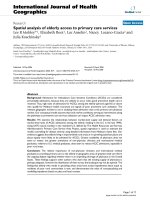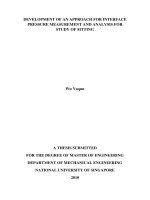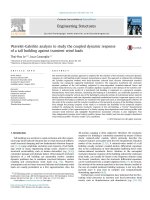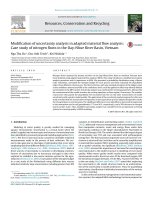spatial analysis cases study
Bạn đang xem bản rút gọn của tài liệu. Xem và tải ngay bản đầy đủ của tài liệu tại đây (282.49 KB, 35 trang )
Spatial Data Analysis Case Studies
Robert J. Hijmans
Aug 13, 2019
CONTENTS
1
1. Introduction
1
2
2. The length of a coastline
3
3
3. Analysing species distribution data
3.1 Introduction . . . . . . . . . . . . . . . . . . . . . . . . . . . . . .
3.2 Import and prepare data . . . . . . . . . . . . . . . . . . . . . . . .
3.3 Summary statistics . . . . . . . . . . . . . . . . . . . . . . . . . . .
3.4 Projecting spatial data . . . . . . . . . . . . . . . . . . . . . . . . .
3.5 Species richness . . . . . . . . . . . . . . . . . . . . . . . . . . . .
3.6 Range size . . . . . . . . . . . . . . . . . . . . . . . . . . . . . . .
3.7 Exercises . . . . . . . . . . . . . . . . . . . . . . . . . . . . . . . .
3.7.1
Exercise 1. Mapping species richness at different resolutions
3.7.2
Exercise 2. Mapping diversity . . . . . . . . . . . . . . . .
3.7.3
Exercise 3. Mapping traits . . . . . . . . . . . . . . . . . .
3.8 References . . . . . . . . . . . . . . . . . . . . . . . . . . . . . . .
.
.
.
.
.
.
.
.
.
.
.
.
.
.
.
.
.
.
.
.
.
.
.
.
.
.
.
.
.
.
.
.
.
.
.
.
.
.
.
.
.
.
.
.
.
.
.
.
.
.
.
.
.
.
.
.
.
.
.
.
.
.
.
.
.
.
.
.
.
.
.
.
.
.
.
.
.
.
.
.
.
.
.
.
.
.
.
.
.
.
.
.
.
.
.
.
.
.
.
.
.
.
.
.
.
.
.
.
.
.
.
.
.
.
.
.
.
.
.
.
.
.
.
.
.
.
.
.
.
.
.
.
.
.
.
.
.
.
.
.
.
.
.
.
.
.
.
.
.
.
.
.
.
.
.
.
.
.
.
.
.
.
.
.
.
.
.
.
.
.
.
.
.
.
.
.
.
.
.
.
.
.
.
.
.
.
.
13
13
13
16
20
21
25
30
30
30
31
31
i
ii
CHAPTER
ONE
1. INTRODUCTION
This is a (still very small) collection of case studies of spatial data analyis with R.
It is part of these Introduction to Spatial Data Analysis with R resources.
1
Spatial Data Analysis Case Studies
2
Chapter 1. 1. Introduction
CHAPTER
TWO
2. THE LENGTH OF A COASTLINE
How Long Is the Coast of Britain? Statistical Self-Similarity and Fractional Dimension is the title of a famous paper
by Bent Mandelbrot. Mandelbrot uses data from a paper by Lewis Fry Richardson who showed that the length of
a coastline changes with scale, or, more precisely, with the length (resolution) of the measuring stick (ruler) used.
Mandelbrot discusses the fractal dimension D of such lines. D is 1 for a straight line, and higher for more wrinkled
shapes. For the west coast of Britain, Mandelbrot reports that D=1.25. Here I show how to measure the length of a
coast line with rulers of different length and how to compute a fractal dimension.
First we get a high spatial resolution (30 m) coastline for the United Kingdom from the GADM database.
library(raster)
uk <- raster::getData('GADM', country='GBR', level=0)
par(mai=c(0,0,0,0))
plot(uk)
3
Spatial Data Analysis Case Studies
This is a single ‘multi-polygon’ (it has a single feature) and a longitude/latitude coordinate reference system.
data.frame(uk)
##
GID_0
NAME_0
## 1
GBR United Kingdom
Let’s transform this to a planar coordinate system. That is not required, but it will speed up computations. We used the
“British National Grid” coordinate reference system, which is based on the Transverse Mercator (tmerc) projection.
prj <- "+proj=tmerc +lat_0=49 +lon_0=-2 +k=0.9996012717 +x_0=400000 +y_0=-100000
˓→+ellps=airy +datum=OSGB36 +units=m"
Note that the units are meters.
With that we can transform the coordinates of uk from longitude latitude to the British National Grid.
library(rgdal)
guk <- spTransform(uk, CRS(prj))
We only want the main island, so want need to separate (disaggregate) the different polygons.
duk <- disaggregate(guk)
head(duk)
##
GID_0
NAME_0
## 1
GBR United Kingdom
(continues on next page)
4
Chapter 2. 2. The length of a coastline
Spatial Data Analysis Case Studies
(continued from previous page)
##
##
##
##
##
2
3
4
5
6
GBR
GBR
GBR
GBR
GBR
United
United
United
United
United
Kingdom
Kingdom
Kingdom
Kingdom
Kingdom
Now we have 920 features. We want the largest one.
a <- area(duk)
i <- which.max(a)
a[i] / 1000000
## [1] 219155.8
b <- duk[i,]
Britain has an area of about 220,000 km2 .
par(mai=rep(0,4))
plot(b)
On to the tricky part. The function to go around the coast with a ruler (yardstick) of a certain length.
measure_with_ruler <- function(pols, length, lonlat=FALSE) {
# some sanity checking
(continues on next page)
5
Spatial Data Analysis Case Studies
(continued from previous page)
stopifnot(inherits(pols, 'SpatialPolygons'))
stopifnot(length(pols) == 1)
# get the coordinates of the polygon
g <- geom(pols)[, c('x', 'y')]
nr <- nrow(g)
# we start at the first point
pts <- 1
newpt <- 1
while(TRUE) {
# start here
p <- newpt
# order the points
j <- p:(p+nr-1)
j[j > nr] <- j[j > nr] - nr
gg <- g[j,]
# compute distances
pd <- pointDistance(gg[1,], gg, lonlat)
# get the first point that is past the end of the ruler
# this is precise enough for our high resolution coastline
i <- which(pd > length)[1]
if (is.na(i)) {
stop('Ruler is longer than the maximum distance found')
}
# get the record number for new point in the original order
newpt <- i + p
# stop if past the last point
if (newpt >= nr) break
pts <- c(pts, newpt)
}
# add the last (incomplete) stick.
pts <- c(pts, 1)
# return the locations
g[pts, ]
}
Now we have the function, life is easy, we just call it a couple of times, using rulers of different lengths.
y <- list()
rulers <- c(25,50,100,150,200,250) # km
for (i in 1:length(rulers)) {
y[[i]] <- measure_with_ruler(b, rulers[i]*1000)
}
Object y is a list of matrices containing the locations where the ruler touched the coast. We can plot these on top of a
map of Britain.
par(mfrow=c(2,3), mai=rep(0,4))
for (i in 1:length(y)) {
(continues on next page)
6
Chapter 2. 2. The length of a coastline
Spatial Data Analysis Case Studies
(continued from previous page)
plot(b, col='lightgray', lwd=2)
p <- y[[i]]
lines(p, col='red', lwd=3)
points(p, pch=20, col='blue', cex=2)
bar <- rbind(cbind(525000, 900000), cbind(525000, 900000-rulers[i]*1000))
lines(bar, lwd=2)
points(bar, pch=20, cex=1.5)
text(525000, mean(bar[,2]), paste(rulers[i], ' km'), cex=1.5)
text(525000, bar[2,2]-50000, paste0('(', nrow(p), ')'), cex=1.25)
}
7
Spatial Data Analysis Case Studies
The coastline of Britain, measured with rulers of different lengths. The number of segments is in parenthesis. f
Here is the fractal (log-log) plot. Note how the axes are on the log scale, but that I used the non-transformed values
for the labels.
8
Chapter 2. 2. The length of a coastline
Spatial Data Analysis Case Studies
# number of times a ruler was used
n <- sapply(y, nrow)
# set up empty plot
plot(log(rulers), log(n), type='n', xlim=c(2,6), ylim=c(2,6), axes=FALSE,
xaxs="i",yaxs="i", xlab='Ruler length (km)', ylab='Number of segments')
# axes
tics <- c(1,10,25,50,100,200,400)
axis(1, at=log(tics), labels=tics)
axis(2, at=log(tics), labels=tics, las=2)
# linear regression line
m <- lm(log(n)~log(rulers))
abline(m, lwd=3, col='lightblue')
# add observations
points(log(rulers), log(n), pch=20, cex=2, col='red')
9
Spatial Data Analysis Case Studies
What does this mean? Let’s try some very small rulers, from 1 mm to 10 m.
small_rulers <- c(0.000001, 0.00001, 0.0001, 0.001, 0.01) # km
nprd <- exp(predict(m, data.frame(rulers=small_rulers)))
coast <- nprd * small_rulers
plot(small_rulers, coast, xlab='Length of ruler', ylab='Length of coast', pch=20,
˓→cex=2, col='red')
So as the ruler get smaller, the coastline gets exponentially longer. As the ruler approaches zero, the length of the
coastline approaches infinity.
The fractal dimension D of the coast of Britain is the (absolute value of the) slope of the regression line.
m
##
## Call:
## lm(formula = log(n) ~ log(rulers))
##
(continues on next page)
10
Chapter 2. 2. The length of a coastline
Spatial Data Analysis Case Studies
(continued from previous page)
## Coefficients:
## (Intercept) log(rulers)
##
8.976
-1.208
Get the slope
-1 * m$coefficients[2]
## log(rulers)
##
1.208451
Very close to Mandelbrot’s D = 1.25 for the west coast of Britain.
Further reading.
11
Spatial Data Analysis Case Studies
12
Chapter 2. 2. The length of a coastline
CHAPTER
THREE
3. ANALYSING SPECIES DISTRIBUTION DATA
3.1 Introduction
In this case-study I show some techniques that can be used to analyze species distribution data with R. Before going
through this document you should at least be somewhat familiar with R and spatial data manipulation in R. This
document is based on an analysis of the distribution of wild potato species by Hijmans and Spooner (2001). Wild
potatoes (Solanaceae; Solanum sect. Petota are relatives of the cultivated potato. There are nearly 200 different
species that occur in the Americas.
3.2 Import and prepare data
The data we will use is available in the rspatial package. First install that from github, using devtools.
if (!require("rspatial")) devtools::install_github('rspatial/rspatial')
## Loading required package: rspatial
The extracted file is a tab delimited text file. Normally, you would read such a file with something like:
f <- system.file("WILDPOT.txt", package="rspatial")
f
## [1] "C:/soft/R/R-3.6.0/library/rspatial/WILDPOT.txt"
d <- read.table(f, header=TRUE)
## Error in read.table(f, header = TRUE): more columns than column names
But that does not work in this case because some lines are incomplete. So we have to resort to some more complicated
tricks.
# read all lines using UTF-8 encoding
d <- readLines(f, encoding='UTF-8')
# split each line into elements using the tabs
dd <- strsplit(d, '\t')
# show that the number of elements varies
table(sapply(dd, length))
##
##
18
19
20
21
22
## 300 1372 170 1511 1647
# function to complete each line to 22 items
fun <- function(x) {
r <- rep("", 22)
r[1:length(x)] <- x
(continues on next page)
13
Spatial Data Analysis Case Studies
(continued from previous page)
r
}
# apply function to each element of the list
ddd <- lapply(dd, fun)
# row bind all elements (into a matrix)
v <- do.call(rbind, ddd)
head(v)
##
[,1] [,2]
[,3]
[,4]
[,5]
[,6]
[,7]
[,8]
## [1,] "ID" "COLNR"
"DATE"
"LongD" "LongM" "LongS" "LongH" "LatD"
## [2,] "55" "OKA 3901" "19710405" "65"
"45"
"0"
"W"
"22"
## [3,] "16" "OKA 3920" "19710406" "66"
"6"
"0"
"W"
"21"
## [4,] "204" "HOF 1848" "19710305" "65"
"5"
"0"
"W"
"22"
## [5,] "545" "OKA 4015" "19710411" "66"
"15"
"0"
"W"
"22"
## [6,] "549" "OKA 4026" "19710411" "66"
"12"
"0"
"W"
"22"
##
[,9]
[,10] [,11] [,12]
[,13]
[,14]
[,15]
## [1,] "LatM" "LatS" "LatH" "SPECIES"
"SCODE_NEW" "SUB_NEW" "SP_ID"
## [2,] "8"
"0"
"S"
"S. acaule Bitter" "acl"
"ACL"
"1"
## [3,] "53"
"0"
"S"
"S. acaule Bitter" "acl"
"ACL"
"1"
## [4,] "16"
"0"
"S"
"S. acaule Bitter" "acl"
"ACL"
"1"
## [5,] "32"
"0"
"S"
"S. acaule Bitter" "acl"
"ACL"
"1"
## [6,] "30"
"0"
"S"
"S. acaule Bitter" "acl"
"ACL"
"1"
##
[,16]
[,17]
[,18]
## [1,] "COUNTRY"
"ADM1" "ADM2"
## [2,] "ARGENTINA" "Jujuy" "Yavi"
## [3,] "ARGENTINA" "Jujuy" "Santa Catalina"
## [4,] "ARGENTINA" "Salta" "Santa Victoria"
## [5,] "ARGENTINA" "Jujuy" "Rinconada"
## [6,] "ARGENTINA" "Jujuy" "Rinconada"
##
[,19]
[,20]
[,21]
## [1,] "LOCALITY"
"PLRV1" "PLRV2"
## [2,] "Tafna."
"R"
"R"
## [3,] "10 km W of Santa Catalina."
"S"
"R"
## [4,] "53 km E of Cajas."
"S"
"R"
## [5,] "\"Near Abra de Fundiciones, 10 km S of Rinconada.\"" "S"
"R"
## [6,] "8 km SW of Fundiciones."
"S"
"R"
##
[,22]
## [1,] "FROST"
## [2,] "100"
## [3,] "100"
## [4,] "100"
## [5,] "100"
## [6,] "100"
#set the column names and remove them from the data
colnames(v) <- v[1,]
v <- v[-1,]
# coerce into a data.frame and change the type of some variables
# to numeric (instead of character)
v <- data.frame(v, stringsAsFactors=FALSE)
The coordinate data is in degrees, minutes, seconds (in separate columns, fortunately), so we need to compute longitude and latitude as single numbers.
# first coerce character values to numbers
(continues on next page)
14
Chapter 3. 3. Analysing species distribution data
Spatial Data Analysis Case Studies
(continued from previous page)
for (i in c('LongD', 'LongM', 'LongS', 'LatD', 'LatM', 'LatS')) {
v[, i] <- as.numeric(v[,i])
}
v$lon <- -1 * (v$LongD + v$LongM / 60 + v$LongS / 3600)
v$lat <- v$LatD + v$LatM / 60 + v$LatS / 3600
# Southern hemisphere gets a negative sign
v$lat[v$LatH == 'S'] <- -1 * v$lat[v$LatH == 'S']
head(v)
##
ID
COLNR
DATE LongD LongM LongS LongH LatD LatM LatS LatH
## 1 55 OKA 3901 19710405
65
45
0
W
22
8
0
S
## 2 16 OKA 3920 19710406
66
6
0
W
21
53
0
S
## 3 204 HOF 1848 19710305
65
5
0
W
22
16
0
S
## 4 545 OKA 4015 19710411
66
15
0
W
22
32
0
S
## 5 549 OKA 4026 19710411
66
12
0
W
22
30
0
S
## 6 551 OKA 4030A 19710411
66
12
0
W
22
28
0
S
##
SPECIES SCODE_NEW SUB_NEW SP_ID
COUNTRY ADM1
ADM2
## 1 S. acaule Bitter
acl
ACL
1 ARGENTINA Jujuy
Yavi
## 2 S. acaule Bitter
acl
ACL
1 ARGENTINA Jujuy Santa Catalina
## 3 S. acaule Bitter
acl
ACL
1 ARGENTINA Salta Santa Victoria
## 4 S. acaule Bitter
acl
ACL
1 ARGENTINA Jujuy
Rinconada
## 5 S. acaule Bitter
acl
ACL
1 ARGENTINA Jujuy
Rinconada
## 6 S. acaule Bitter
acl
ACL
1 ARGENTINA Jujuy
Rinconada
##
LOCALITY PLRV1 PLRV2 FROST
## 1
Tafna.
R
R
100
## 2
10 km W of Santa Catalina.
S
R
100
## 3
53 km E of Cajas.
S
R
100
## 4 "Near Abra de Fundiciones, 10 km S of Rinconada."
S
R
100
## 5
8 km SW of Fundiciones.
S
R
100
## 6
"Salveayoc, 5 km SW of Rinconada."
S
R
100
##
lon
lat
## 1 -65.75000 -22.13333
## 2 -66.10000 -21.88333
## 3 -65.08333 -22.26667
## 4 -66.25000 -22.53333
## 5 -66.20000 -22.50000
## 6 -66.20000 -22.46667
Get a SpatialPolygonsDataFrame with most of the countries of the Americas.
library(raster)
library(rspatial)
cn <- sp_data('pt_countries')
proj4string(cn) <- CRS("+proj=longlat +datum=WGS84")
class(cn)
## [1] "SpatialPolygonsDataFrame"
## attr(,"package")
## [1] "sp"
Make a quick map
plot(cn, xlim=c(-120, -40), ylim=c(-40,40), axes=TRUE)
points(v$lon, v$lat, cex=.5, col='red')
3.2. Import and prepare data
15
Spatial Data Analysis Case Studies
And create a SpatialPointsDataFrame for the potato data with the formula approach
sp <- v
coordinates(sp) <- ~lon + lat
proj4string(sp) <- CRS("+proj=longlat +datum=WGS84")
Alternatively, you can do
sp <- SpatialPoints( v[, c('lon', 'lat')],
proj4string=CRS("+proj=longlat +datum=WGS84") )
sp <- SpatialPointsDataFrame(sp, v)
3.3 Summary statistics
We are first going to summarize the data by country. We can use the country variable in the data, or extract that from
the countries SpatialPolygonsDataFrame.
16
Chapter 3. 3. Analysing species distribution data
Spatial Data Analysis Case Studies
table(v$COUNTRY)
##
##
ARGENTINA
BOLIVIA
##
1474
985
##
COSTA RICA
ECUADOR
##
24
138
##
MEXICO
PANAMA
##
843
13
## UNITED STATES
URUGUAY
##
157
4
# note Peru and PERU
v$COUNTRY <- toupper(v$COUNTRY)
table(v$COUNTRY)
##
##
ARGENTINA
BOLIVIA
##
1474
985
##
COSTA RICA
ECUADOR
##
24
138
##
PANAMA
PARAGUAY
##
13
19
##
VENEZUELA
##
12
BRAZIL
17
GUATEMALA
59
PARAGUAY
19
VENEZUELA
12
CHILE
100
HONDURAS
1
Peru
1
COLOMBIA
107
Mexico
2
PERU
1043
BRAZIL
CHILE
17
100
GUATEMALA
HONDURAS
59
1
PERU UNITED STATES
1044
157
COLOMBIA
107
MEXICO
845
URUGUAY
4
# same fix for the SpatialPointsDataFrame
sp$COUNTRY <- toupper(sp$COUNTRY)
Below we determine the country using a spatial query, using the “over” function.
ov <- over(sp, cn)
colnames(ov) <- 'name'
head(ov)
##
name
## 1 ARGENTINA
## 2 ARGENTINA
## 3 ARGENTINA
## 4 ARGENTINA
## 5 ARGENTINA
## 6 ARGENTINA
v <- cbind(v, ov)
table(v$COUNTRY)
##
##
ARGENTINA
BOLIVIA
##
1474
985
##
COSTA RICA
ECUADOR
##
24
138
##
PANAMA
PARAGUAY
##
13
19
##
VENEZUELA
##
12
BRAZIL
CHILE
17
100
GUATEMALA
HONDURAS
59
1
PERU UNITED STATES
1044
157
COLOMBIA
107
MEXICO
845
URUGUAY
4
This table is similar to the previous table, but it is not the same. Let’s find the records that are not in the same country
according to the original data and the spatial query.
# some fixes first
# apparantly in the ocean (small island missing from polygon data)
v$name[is.na(v$name)] <- ''
# some spelling differenes
(continues on next page)
3.3. Summary statistics
17
Spatial Data Analysis Case Studies
(continued from previous page)
v$name[v$name=="UNITED STATES, THE"] <- "UNITED STATES"
v$name[v$name=="BRASIL"] <- "BRAZIL"
i <- which(toupper(v$name) != v$COUNTRY)
i
## [1] 581 582 1367 1617 1635 1951 1952 1953 1954 2804 2805 2855 2856 3223
## [15] 3525
plot(cn, xlim=c(-120, -40), ylim=c(-40,40), axes=TRUE)
points(sp, cex=.25, pch='+', col='blue')
points(sp[i,], col='red', pch='x', cex=1.5)
All observations that are in a different country than their attribute data suggests are very close to an international
border, or in the water. That suggests that the coordinates of the potato locations are not very precise (or the borders
are inexact). Otherwise, this is reassuring (and a-typical). There are often are several inconsistencies, and it can be
hard to find out whether the locality coordinates are wrong or whether the borders are wrong; but further inspection is
warranted in those cases.
18
Chapter 3. 3. Analysing species distribution data
Spatial Data Analysis Case Studies
We can compute the number of species for each country.
spc <- tapply(v$SPECIES, sp$COUNTRY, function(x)length(unique(x)) )
spc <- data.frame(COUNTRY=names(spc), nspp = spc)
# merge with country SpatialPolygonsDataFrame
cn <- merge(cn, spc, by='COUNTRY')
print(spplot(cn, 'nspp', col.regions=rev(terrain.colors(25))))
The map shows that Peru is the country with most potato species, followed by Bolivia and Mexico. We can also
tabulate the number of occurrences of each species by each country.
tb <- table(v[ c('COUNTRY', 'SPECIES')])
# a big table
dim(tb)
## [1] 16 195
# show two columns
tb[,2:3]
(continues on next page)
3.3. Summary statistics
19
Spatial Data Analysis Case Studies
(continued from previous page)
##
SPECIES
## COUNTRY
S. acaule Bitter
˓→rdenas
##
ARGENTINA
238
##
BOLIVIA
114
##
BRAZIL
0
##
CHILE
0
##
COLOMBIA
0
##
COSTA RICA
0
##
ECUADOR
0
##
GUATEMALA
0
##
HONDURAS
0
##
MEXICO
0
##
PANAMA
0
##
PARAGUAY
0
##
PERU
52
##
UNITED STATES
0
##
URUGUAY
0
##
VENEZUELA
0
S. achacachense C<U+643C><U+3E66>
0
8
0
0
0
0
0
0
0
0
0
0
0
0
0
0
Because the countries have such different sizes and shapes, the comparison is not fair (larger countries will have more
species, on average, than smaller countries). Some countries are also very large, hiding spatial variation. The map the
number of species, it is in most cases better to use a raster (grid) with cells of equal area, and that is what we will do
next.
3.4 Projecting spatial data
To use a raster with equal-area cells, the data need to be projected to an equal-area coordinate reference system (CRS).
If the longitude/latitude date were used, cells of say 1 square degree would get smaller as you move away from the
equator: think of the meridians (vertical lines) on the globe getting closer to each other as you go towards the poles.
For small areas, particularly if they only span a few degrees of longitude, UTM can be a good CRS, but it this case we
will use a CRS that can be used for a complete hemisphere: Lambert Equal Area Azimuthal. For this CRS, you must
choose a map origin for your data. This should be somewhere in the center of the points, to minimize the distance (and
hence distortion) from any point to the origin. In this case, a reasonable location is (-80, 0).
library(rgdal)
# "proj.4" notation of CRS
projection(cn) <- "+proj=longlat +datum=WGS84"
# the CRS we want
laea <- CRS("+proj=laea +lat_0=0 +lon_0=-80")
clb <- spTransform(cn, laea)
pts <- spTransform(sp, laea)
plot(clb, axes=TRUE)
points(pts, col='red', cex=.5)
20
Chapter 3. 3. Analysing species distribution data
Spatial Data Analysis Case Studies
Note that the shape of the countries is now much more similar to their shape on a globe than before we projected You
can also see that the coordinate system has changed by looking at the numbers of the axes. These express the distance
from the origin (-80, 0) in meters.
3.5 Species richness
Let’s determine the distribution of species richness using a raster. First we need an empty ‘template’ raster that has the
correct extent and resolution. Here I use 200 by 200 km cells.
r <- raster(clb)
# 200 km = 200000 m
res(r) <- 200000
Now compute the number of observations and the number of species richness for each cell.
3.5. Species richness
21









